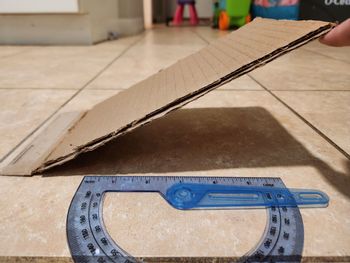3. Choose two different shoes (sneaker and dress shoe, work boot and slipper, etc.). These can be your own or someone else's (those of spouse, child, friend, etc.) They do not have to be new- use whatever condition. any have, in you 4. Place one shoe at one end of a ramp of any material that will not bend or deform under the shoe's weight. (Use wood, metal, plastic, or even heavy-duty cardboard for the ramp.) Make sure the sole of the shoe and the ramp are relatively clean of debris. a. Slowly raise the "shoe end" of the ramp until the shoe begins to slide. Measure and record the angle of the ramp just as sliding begins. You can measure the angle with a protractor or using a height measurement and a trig function. NOTE: The shoe doesn't have to slide all the way down the ramp; actually, you want to capture the angle at which shoe begins to move. b. Do this six times. Note that your angles should be fairly consistent. If any angle seems inconsistent with the other angles, discard it and try again. In the end, you should have six consistent (but not necessarily equal) angles. 5. Repeat the process with the second shoe. Analysis 1. Using the six measured angles for each shoe, find the average angle at which each shoe begins to slide. 2. Using the equation we derive in class, calculate us for each shoe using the average angle for each shoe. Only one calculation is needed for each shoe. 3. Is average us the same for each shoe? How closely does average us match accepted values? Some accepted values or ranges can be found at https://www.engineeringtoolbox.com/friction- coefficients-d 778.html. If you can't find the coefficient for your combination of materials, google the materials (for example, "coefficient of static friction between leather and cardboard" and see what you can find.) Alternatively, consider some close to your surface materials and note this in your presentation.
I re-did the calculations for the angles, when i submitted this previously there was an error because angles were over 90 degrees.


Trending now
This is a popular solution!
Step by step
Solved in 3 steps with 2 images

I dont know what I am doing wrong, i did it again and moved the protractor. i got the angles 85, 82, 78 84, 80 and 76 for shoe number 1, for shoe number 2 i got 82, 86, 85, 88, 84 and 83. average for shoe 1 comes to 80.83 and for shoe 2 comes to 84.67. i attached a picture of my ramp made of cardboard. the professor said if we get over 4.0 is way off and wrong, so i am definitly way off what am i doing wrong while taking these angles? the shoes are a croc clog and a mocassin slipper, i am slowly raising the cardboard ramp until they begin to slide and when that happens i take the angle on which it happened by looking at the protractor which is held standing behind the cardboard.









